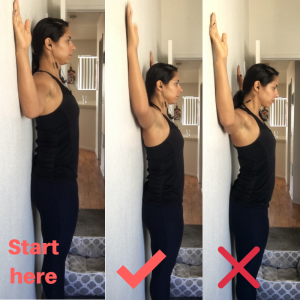Believe it or not, but just because you can press weights overhead right now doesn’t mean that you should….yet. The majority of us adult athletes and weekend warriors aren’t ready for overhead work simply because we haven’t earned the right to do so, and we rarely question it. We just dive right in to a MetCon and hope for the best.
Thankfully I made this mistake so you don’t have to. It took me years and a shoulder injury to understand that there was so much to overhead pressing other than the physical capability to lift my arms up. Avoid frustration and injuries and start training smarter.
Mobility Requirement for a Safe Press
Pressing weight overhead isn’t as simple as lifting the arms up. This movement is very demanding, which is why many of us aren’t prepared for it. The components of a safe and strong overhead press include:
- Proper shoulder flexion
- Thoracic mobility
- Lumbo-pelvic control
- Shoulder motor control
Just because you can physically press a dumbbell or barbell overhead right now without pain, doesn’t it’s all good either. We must assess where we are at in order to determine which exercises are best suited for us. This doesn’t mean you will never be able to do a military press with a barbell (if that’s what you want). It just means you’ll need to work on getting there.
If you’re not ready to press overhead, you may see one or more of these common compensations:
- Forward head posture
- Extended lumbar spine (think: an excessive arch)
- Shrugged shoulders
- Aggressive rib cage flare
Are You Ready? Take This Test
These two tests are easy to do on your own to check if you’re cleared to press. Use a camera or have someone film you so you can see for yourself.
T-Spine Extension Test
The T(horacic) spine needs to extend enough to allow those shoulder blades to move as you press weight overhead. If the T-spine is immobile, it forces the front of the shoulder and lumbar spine to extend instead. Can you see why this might lead to injury?
To test T-spine mobility, one of the requirements of a safe overhead press, do this:
- Lean up against a wall with arms bent 90 degrees on either side.
- Head, butt and back should be up against the wall (I have a big butt so it doesn’t appear like I am against the wall so just work with your body)
- Slide your arms up overhead, staying in contact with the wall
- If your posture doesn’t change like in the second photo, you are good to go on the T-Spine mobility front
- If your head or back pulls away from the wall as you slide the arms up against the wall, you are not ready to press overhead yet
Shoulder flexion test
The next test is also fairly simple and can be performed in front of a mirror but I prefer that you take a video of yourself to review after. You’re watching for similar compensations listed above, except instead of looking at the spine, we’re looking at what’s going on with the shoulder.
- Stand tall with your arms on either side
- Lift your arms in front of you until they are up beside your ears.
- See if you can lift those arms without your head pushing forward, elbows bending, arching your low back, or the shoulders shrugging up to your ears.
- If you feel pain or you find you can’t lift those arms up overhead without your elbows bending, low back extending, shoulders shrugging, or head pushing forward you are not cleared to overhead press…yet.
This back to wall shoulder flexion test from Eric Cressey is also a good one to use:
Keep in mind that these tests only reveal what’s going on in the spine and shoulders. We haven’t addressed pelvic stability and shoulder motor control (that’s for another day and post). But if you can start with these two areas and start working on the exercises that will improve T-spine mobility and shoulder flexion, you can re-test and see if you’re good to go for overhead pressing.



Comments 1
Pingback: Four Exercises for Pain-Free Overhead Pressing - Barbell Pilates with Trish DaCosta